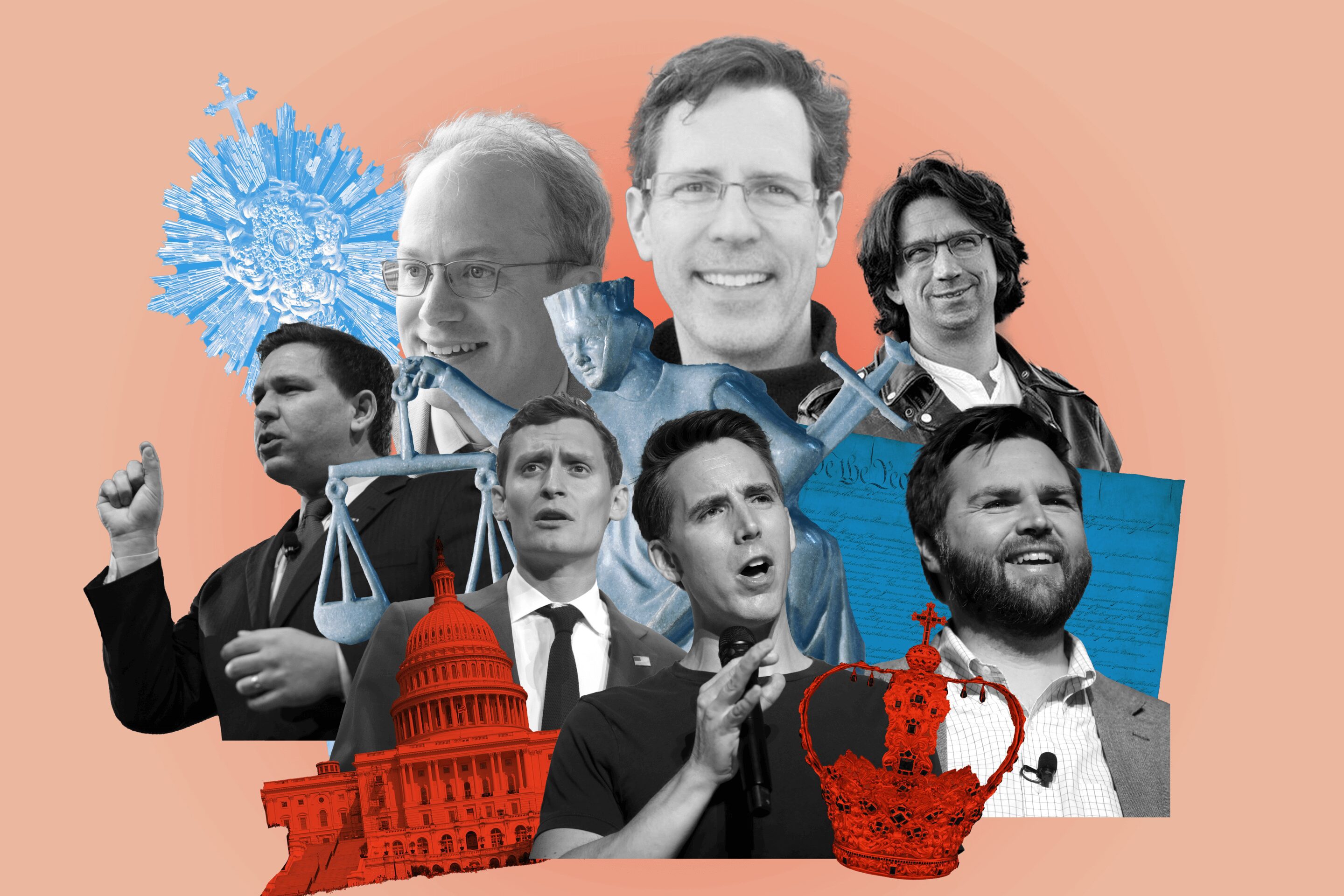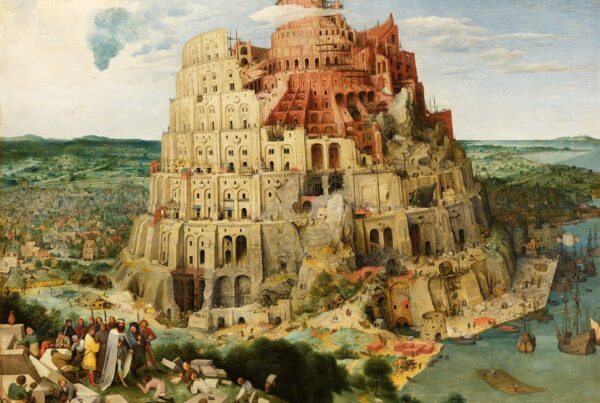“Liberalism needs an enemy to maintain its sacramental dynamism. It can never rest in calm waters, basking in the day of victory; it is essential that at any given moment there should be a new battle to be fought.”
- Adrian Vermeule, “Liturgy of Liberalism,” First Things
“Few want to admit the reality of the situation, but Americans are now divided over the building blocks and the purpose of human civilization. Many do not consider what underlies all the factionalism amidst the noise, but this does not change the sordid reality. There is no possibility of reconciling this fundamental opposition unless one side or the other wins.”
- Matthew Peterson, “The Way Forward,” American Mind
“The right response to any abomination of power has nothing to do with the abomination. The right response is to capture as much power as possible— normally, all the power. Each abomination is just one more count on the endless rap sheet of the old regime.”
- Curtis Yarvin, “Manual for Monarchy,” The Asylum
It is not hard to find evidence of a legitimacy crisis in many Western democracies, and perhaps especially in the United States itself. Today, questions abound about the basic trustworthiness of the political opposition, even as unease grows surrounding cultural change, institutional stability, and the political, economic, and environmental legacies we will leave future generations. This sense of social dislocation and uncertainty has serious consequences, not least deep political discontent across the partisan spectrum.
One unexpected aspect of this crisis has been the explosion in ideological ferment on the American political Right. Distemper with the status quo has generated a panoply of niche ideational trends and intellectual entrepreneurs promoting visions of our common future very different from old partisan assumptions. As more and more of our political and social discourse moves to online venues, the contours of that discourse have gotten weirder – even compared to the distant era of 2010.
In general, we can describe this diverse ideological ecosystem on the American Right as characterized by a shared ‘illiberalism,’ in the sense that proponents self-consciously reject the assumptions and norms of 21st century liberalism, as expressed in political, economic, or sociocultural forms. Ideology is, of course, more than just opposition or grievance, but a coherent and systematic worldview justified on intellectual or ideational grounds, to which a substantive political project that can be derived and acted upon.
In fairness, the academic label of ‘illiberal’ can be a bit misleading, if only by implying greater structure and coherence to a wide-ranging sprawl of ideas, political thinkers, online communities, and actual politicians than is truly warranted. We are currently better placed to note rather a general ‘family resemblance,’ identifying a fairly clear line of critique – against pervasive liberalism, autonomic individualism, and moral-cultural fragmentation – than a single set of answers or a unified political movement, per se.
The American set of illiberal views is quite diffuse, and certain strands even stand in opposition to others. Even so, some have attempted to attach the umbrella term ‘the New Right’ to its most substantive expressions, while others prefer the ‘dissident’ Right or other monikers such as ‘postliberalism.’ But given all of this – what has emerged from all this ideological creativity in online corners, and most importantly, does any of this actually matter for real American political life?
The ‘Dissident’ Ecosystem, An Insufficient Snapshot
Every article attempting to enforce order on all this ferment will run up against problems of categorization. Some groups are indeed collections of likeminded intellectual colleagues, others are just a disjointed set of very different writers arguing for similar solutions or moral frameworks. Some are self-evidently ‘dangerous’ to democracy as it exists in American today, others are quite obviously compatible. Association by implication is a major analytic problem here. Cue further distinctions and nuances. Yet a taste of selections taken from the ideological diversity on the Right includes the following:
- ‘national-conservatives’ seeking restoration of both economic and cultural nationalism and a defense of cultural specificity;
- heterodox self-help evangelists merging sharp commercial instincts with self-actuated solutions to political and social dissatisfaction;
- Catholic ‘integralists’ and ‘postliberals’ arguing for a revision of society away from secularism and towards a religious, communal approach to human flourishing;
- Silicon Valley-adjacent promoters of tech-optimistic social projects seeking to remake cadres of future elites in their own image;
- collaborative publication projects of post-left and illiberal-right thinkers and cultural critics;
- provocative and Nietzschean ‘vitalists’ developing counter-cultural philosophies of life based in extreme masculine fitness;
- and even a small selection of outright ‘authoritarian theorists’ making unobscured arguments about the deficiencies and failures of democracy itself.
These movements have largely developed online and among niche internet publication outlets, yet their real-world impact beyond the realm of ideas has begun to show fruit. It is no longer unusual for even major establishment figures on the Right to describe the US government as a hostile ‘regime,’ or new, conservative-inflected organizations to describe domestic institutions as so captured by ideological opponents that they are better off being destroyed than rehabilitated.
We are beyond backlash and well into the world of actual Reaction. More to the point, this reaction is no longer merely rhetorically expressed, but has begun to take substantive form.
From Illiberal Critique to Substantive Projects
Perhaps most important for any serious analysis of these ideological tendencies is to recognize that the movement from critique and naysaying to substantive political projects is now thoroughly in motion. It is no longer sufficient to simply mention that there are groups with growing readerships that do not support the status quo of modern American politics and society.
Indeed, laundry-list overviews such as those above actually obscure where the real action is today. While many of the most full-throated challenges to liberalism remain largely confined to written works and idle ‘sh*tpoasting’ in online fora, outgrowths from these ideological spaces are now appearing in the real political world, and in very distinct ways.
It is instructive here to take a few examples from these many varieties of illiberal thought to spell out what the translation from online ideas to actually-existing American politics and society has looked like so far.
Illiberal Ideologies in Action
One small group that has achieved oversized influence – and attention from other corners – within the illiberal intellectual milieu is a selection of conservative Catholic thinkers known as integralists. In brief, their philosophical and theological commitments amount to a form of forthright political Catholicism that at its more maximalist demands a substantively and thoroughly Catholicized American state and society.
The Catholic integralist project thus far remains a marginal one at the level of theology or political philosophy. If one is a Catholic intellectual, indeed the integralist challenge is part of a much larger debate about the Church and her relationship to modernity. But for the short- and medium-term of American politics, one can rest assured that breathless assertions of creeping Papal theocracy or incipient ‘clerico-fascism’ are mostly a waste of analytical effort.
Yet one much more interesting outflow of integralist and integralist-influenced discussion circles has been the development of a more practical effort at revitalizing the concepts of the natural law and the common good for American legal-constitutional interpretation. This has taken initial form as a project for ‘common-good constitutionalism,’ spearheaded by the integralist Harvard professor Adrian Vermeule as a replacement for the philosophical and functional failures of legal originalism. Indeed, it has already engendered a full debate in the American legal field and holds a growing cohort of adherents among conservative law school students.
Another ideational strand with real-world implications has been the ‘national-conservative’ project, a halfway house between the more protectionist and nationalist elements of the GOP establishment and harsher repudiations of the entire post-Cold War direction of American liberalism. Here we find the clearest associations with actual aspiring politicians, such as J. D. Vance in Ohio or Blake Masters in Arizona, as well as ambitious current-set politicos like Josh Hawley and Ron DeSantis. Although others on the Right sometimes suggest see ‘NatCons’ as a kind of reskinned Republican Party redux, the national-conservative tendency rather distinctly echoes European statist right-wing parties of Central and Eastern Europe.
The national-conservatives are by far the most mainstream among the illiberal strands of the Right today, yet it is clear that they read widely across the broader field of dissident right-wing thought. Indeed, in some ways they seem to be a clearinghouse for very different ideological tendencies to find purchase in the actual American political system. In this sense, for now they also provide the function of buy-in into existing democratic electoral politics that other illiberal sub-groups otherwise do not yet touch in overt ways.
Finally, as far as substantive projects are concerned, it is still unclear what to make of the harshest critics of the modern American polity themselves. These are the ‘authoritarian theorists’ such as the tech-aligned ‘monarchist’ Curtis Yarvin or the Bonapartist advocate Charles Haywood. These writers (who are read far more widely and in more influential circles than you might think) counsel the need for outright authoritarian regimes as superior successors to American democracy.
Although deep in the weeds of online writing, they have been given growing attention in both illiberal publications such as those hosted by the conservative Claremont Institute, as well as features in mainstream media, including the New York Times, Vanity Fair, Vox, and Tucker Carlson. Indeed, a surprising amount of vocabulary and framings used in illiberal Right circles can be traced to these figures. And some illiberal politicians are even open about reading these sorts of work as well.
These real advocates of authoritarian rule are being read by more people than ever, and their radical evocation of living under a hostile regime has found fertile ground, even if their solutions are not accepted. Of course, readership and a certain terminological cast does not mean a constructive (or if you like, destructive) authoritarian project yet exists in full. There is no real authoritarian party or mass social movement waiting in the wings to overthrow the US government, despite the popularization of a Caesarist projection of America’s future. And true authoritarian theorists may be ill-fitting with other, more institutional elements of the illiberal Right. Yet the mainstreaming of doubts about democracy is itself a notable development, to say the least.
Where Do We Go from Here?
All of this amounts to a lesson in reading modern day politics – and the subterranean dynamics that spur its new manifestations – with eyes wide open. With apologies to the thoroughly-misread Francis Fukuyama, history has obviously not ended, and post-Cold War American liberalism is far away from its last or only stop. We are in an era of political disequilibrium, not stability, and this crisis of legitimacy is not going to go away any time soon. And the illiberal Right, once known more for critique than anything else, is growing up.
To take an evolving example, a recent conference at the Franciscan University of Steubenville managed to bring together national-conservatives, integralists, and postliberals together in a pow-wow on political economy and its moral order. These are only two of the many ideological strands of American illiberalism (in some ways its largest and smallest set of adherents, respectively) and with major disputes about right religion, the nation, and ultimate loyalties, as well as a history of personal tensions between them.
Yet the conference illuminated a real consensus view that a political alliance at the ideological level was certainly possible. The national-conservative focus on national developmentalism, economic protectionism, American nationalism, and foreign policy retrenchment could indeed mesh with the muscular social conservatism and activist Catholicism of integralists and postliberals, despite potentially fundamental differences over metaphysical commitments and approaches to politics. One critic jokingly termed this on social media to be a kind of “Pro-Life New Dealism,” which was quickly taken on as a compliment by many of the conference speakers. Other critics, as is tradition, rather preferred recourse to accusations of fascism.
It remains to be seen how the 2020s will shake out in American politics, let alone in the realm of political thought and ideas. The discontented Right is quite clearly the most ideologically creative in this moment, although what that means for the future of politics will remain uncertain for some time. Yet the switch from critical, ideological writing to concrete action is by far the most important takeaway from the last six years, and observers (critical or otherwise) are best served looking where ideas meet reality.
Dr. Julian G. Waller is a Professorial Lecturer in Political Science at George Washington University, a Visiting Scholar at the Institute for European, Russian and Eurasian Studies and a Non-Resident Fellow at the Illiberalism Studies Program. All views are his own and do not represent his employers or affiliated organizations.
Photo by John Chrobak made using “J. D. Vance by Gage Skidmore” by Gage Skidmore licensed under CC BY-SA 3.0; “Blake Masters (52289913852)” by Gage Skidmore licensed under CC BY-SA 2.0; “Josh Hawley (52250580348)” by Gage Skidmore licensed under CC BY-SA 2.0; “Ron DeSantis (25303691390)” by Gage Skidmore licensed under CC BY-SA 2.0; “Église Saint-Jérôme de Toulouse – ostensoir reliquaire de la Vraie Croix” by Didier Descouens licensed under CC BY-SA 4.0; “US Capitol west side” by Martin Falbisoner licensed under CC BY-SA 3.0; “Justice” by Ludmila Kvapilova licensed under CC BY-SA 4.0







